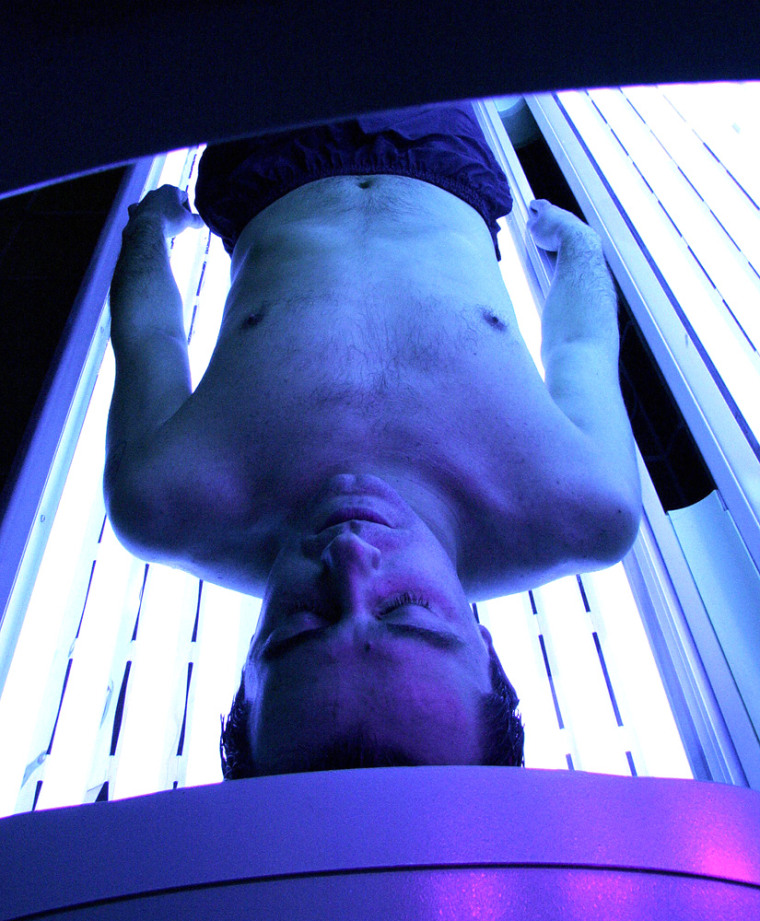A couple of high school students in my neighborhood recently told me they are getting ready to hit the beach this summer by tuning up their suntans inside tanning beds.
When I asked one of my colleagues here at Penn, Dr. William James, a professor of dermatology, if the high school students had the right idea about getting a head start on a tan, he laughed out loud. A tan, he said, represents nothing more than damage to the skin. It is the body trying to defend itself against an environmental hazard — too much UV light. In other words, indoor tanning gets you ready for the beach in the same way that getting scalded in a hot tub gets you ready to be boiled alive.
So who is to blame for the idea that damaged skin is beautiful? Why do so many societies view a tan as a sign of radiant health rather than as a sign that you are starting to resemble a charcoal broiled steak? The main culprit, of course, is the fashion industry.
Prior to the 20th century women were fanatical about avoiding exposure to the sun. Umbrellas and parasols went everywhere with any woman who could afford them. The French fashion designer Coco Chanel changed all that.
Back in the 1920s, Coco, looking to create a new “healthy” look to promote summer wear, popularized tanned skin. Women began sunbathing and those with a tan were seen in high society as beautiful. Voila! Skin damage as fashion accessory. You’ve gotta love an industry that has made anorexia and damaged skin cool.
Other interests piled on to make dough out of burnt skin. The beauty and suntan lotion businesses make billions every year selling goop so we can lounge in the sun with far less protection then the industry would have you believe their nostrums provide.
The travel industry also likes this look. Having a tan in the winter means the toasted soul has taken a vacation in an exotic, warm climate. That’s why hotels and travel promoters regale us with images of people with brown, damaged skin frolicking around pools and beaches without a hat, a coverup or an umbrella in sight.
But worst of all in promoting pre-cancerous tissue as healthy is the indoor tanning industry, led by its corporate arm the Indoor Tanning Association.
This outfit actually launched a PR campaign earlier this year, and I am quoting now, titled “Attacking Melanoma Hype.” The press release contains a quote the likes of which has not been seen since Big Tobacco was lying through its teeth to Congress about the safety of smoking. Sarah Longwell, spokeswoman for the ITA, actually said in a recent press release: “Both the sun and tanning beds have been unnecessarily demonized by special interests using junk science and scare tactics.”
Just so we all understand what is going on here, the alligator-skinned guy who runs the tanning parlor down at the local strip mall has formed an association with other wrinkle promoters. This leathery cabal has declared that the industry they run is legitimate, that the machines they use are great, that kids should use their services, too, and that there is no problem getting tanned year-round and, oh yeah, you should stop paying attention to those doctors, cancer societies and grieving family members mumbling about melanomas.

Don’t get me wrong. There is nothing good about outdoor tanning either. Whether you bake your skin on the beach or in a tanning parlor, the evidence that both are bad for you is overwhelming.
Half of all cancers in the United States are skin cancers. Melanoma, the most serious type of skin cancer, accounts for about 60,000 cases and causes 11,000 deaths every year in the U.S. We spend nearly a billion dollars each year treating melanomas.
So who are you going to listen to — a bunch of folks in white coats* with lots of degrees who make money sawing cancerous bits off sun worshippers — or the guy with a store full of coffins with light bulbs at a strip mall?
Don’t buy what the tanning industry is selling. Save your hide.
* According to the American Cancer Society, unprotected and/or excessive exposure to ultraviolet (UV) radiation causes skin cancer. Add to the list: the Working Group of the International Agency for Research on Cancer IARC, the American Academy of Dermatology, the Canadian Cancer Society, the Skin Cancer Foundation, the British Medical Association, the Australian Medical Association and the Cancer Society of New Zealand.
Arthur Caplan, Ph.D., is director of the Center for Bioethics at the University of Pennsylvania.
